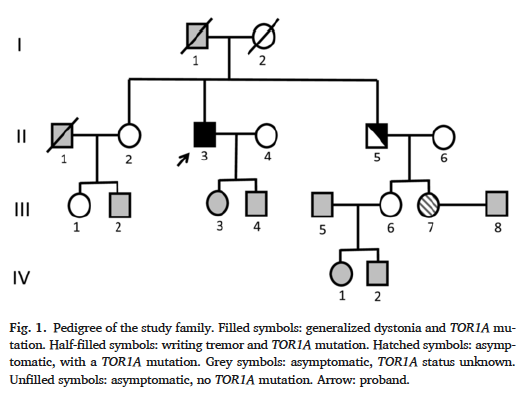Session Information
Date: Sunday, October 7, 2018
Session Title: Dystonia
Session Time: 1:45pm-3:15pm
Location: Hall 3FG
Objective: Writing tremor is not always a primary writing tremor but can undermask a dystonia gene-associated tremor.
Background: Dystonia gene-associated tremor corresponds to isolated tremor observed in patients with a mutation known to cause dystonia; dystonic posture is sometimes observed over the course of the disease. This entity is challenging to diagnose; for example, it can be difficult to differentiate from essential tremor. Primary writing tremor is different in that no causal mutation was demonstrated in this disorder.
Methods: Here, we report on a family with two affected members (Fig. 1). The index case (II:3) presented with generalized dystonia from the age of 10 onwards. A TOR1A mutation (c.907delGAG) was identified. His brother (II:5) presented with mild, progressive writing difficulties from the age of 42 onwards (in 1990). After an initial consultation in 1999, writing tremor with jerky pronosupination developed over the next 13 years. The patient consulted again in September 2016. The clinical situation had changed dramatically; we observed marked dystonic flexion of the right wrist, associated with an irregular, postural, kinetic tremor of both hands.
Results: Polymyographic electromyography ruled out essential tremor and myoclonus. TOR1A mutation turned out to be positive in the II:5 patient. It cannot be determined whether, at the onset of the disease, patient II:5 presented with dystonic tremor or isolated tremor (dystonia gene-associated tremor). Indeed, although dystonia gene-associated tremor is a classical concept, cases are very rare. The clinical presentation of patient II:5 was remarkable for a DYT1 dystonia: late onset (42 years old, whereas DYT1 dystonia typically presents in childhood or adolescence); mild phenotype (a focal,task-specific dystonic tremor); and slow course (the patient’s dystonic posture became worse more than 20 years after the onset).
Conclusions: In summary, screening for mutations (especially a TOR1A mutation or a SGCE mutation) should be considered in patients with writing tremor when there is a family history of dystonia. However, it should be borne in mind that all forms of genetically determined dystonia may present with tremor of the hand. Lastly, in patients with dystonia gene-associated writing tremor, dystonia may occur after several decades.
References: G. Defazio, A. Conte, A.F. Gigante, G. Fabbrini, A. Berardelli, Is tremor in dystonia a phenotypic feature of dystonia?, Neurology 84 (2015) 1053–1059, https://doi. org/10.1212/WNL.0000000000001341. R. Erro, M. Ciocca, S.T. Hirschbichler, J.C. Rothwell, K.P. Bhatia, Primary writing tremor is a dystonic trait: evidence from an instructive family, J. Neurol. Sci. 356 (2015) 210–211, https://doi.org/10.1016/j.jns.2015.06.040.
To cite this abstract in AMA style:
C. Aerts, F. Cassim, I. Strubi-Vuillaume, A. Destee, B. Sablonnière, G. Collod-Béroud, L. Defebvre, A. Kreisler. Writing tremor: Should we look for a TOR1A mutation? [abstract]. Mov Disord. 2018; 33 (suppl 2). https://www.mdsabstracts.org/abstract/writing-tremor-should-we-look-for-a-tor1a-mutation/. Accessed April 20, 2025.« Back to 2018 International Congress
MDS Abstracts - https://www.mdsabstracts.org/abstract/writing-tremor-should-we-look-for-a-tor1a-mutation/

